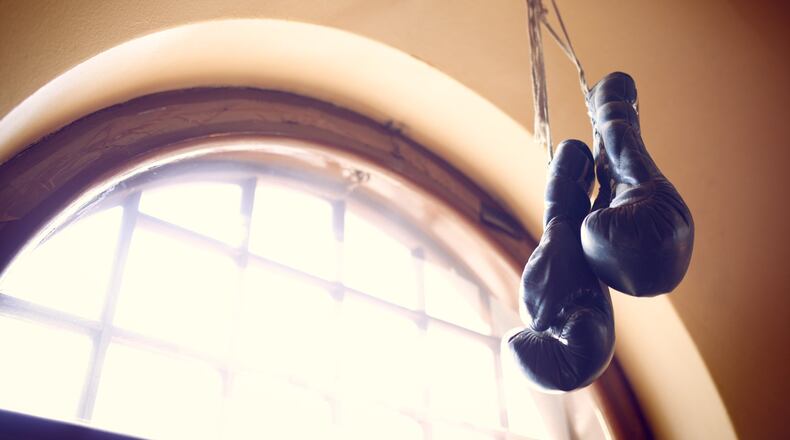But Roberts knows enough.
He’s been there to photograph the gloves, receive a clear but polite “no” about whether they are for sale, and seen a plaque that briefly describes the career of the Springfield native son and world flyweight champion.
Roberts said he had a hard time finding the restaurant, Juttutupa, , even though “Helsinki and Finland are second homes” to him and others at Springfield’s Konecranes office.
The Finnish-based company’s other major offices are in Shanghai and Hyvinkaa, Finland.
An old blue collar town of 60,000 about 45 minutes outside Helsinki, Hyvinkaa is “almost a mirror image of Springfield,” Roberts said.
And just as Konecranes shares a parcel of land in the Prime Ohio Corporate park here with Robbins & Myers, whose industrial lift business it took over in 1983, it shares a campus in Finland with Kone elevators, where it got its start in the 1880s since has separated.
“I have a handful of vendors around the world we do our digital marketing with,” Roberts explained, and during an April visit to Helsinki “had met with them in the morning.”
What sent him that afternoon toward the Siltasaari part of the city (it translates as “bridge-island”) was an item he found in a Wikipedia entry on Moore.
“My kids, Madison and Jordan, go to Emmanuel Christian (Academy),” Roberts explained.
To support them and the school, he agreed to help with a silent auction. One of the items was a painting of Moore done by artist Ron Stephens (who is John Legend’s father), and donated by school backer John Landess.
Out of respect for Moore’s career and memory — and to encourage bidding — “I wanted to make sure I told the story well,” Roberts said.
That sent him on the Internet search that turned up the detail about the gloves. And that led to an obvious question.
“What in the world are they doing in Helsinki?”
“He actually boxed there twice,” Roberts said.
“When he boxed in the Olympics they were in Helsinki.”
That was in July of 1952. Moore drew a bye in the first round of the 119-pound competition, then used what a wire story called “persistent short rights to the jaw” to take charge in the second round of his bout with German Egon Schidan.
Both Moore, who characterized himself as a street fighter, and Schidan were “warned frequently by ring officials” about their tactics later in the fight, which Moore won by unanimous decision.
His afternoon match two days later resulted in a controversial defeat to Joon Ho Kong.
“Boxing calmly and smoothly,” wire reports said, “Moore met most of the Korean’s wild rushes with neat, crisp left and right hand counters. In the third round, Moore staggered his taller rival with a left hook and solid right uppercut, but the Korean shook off the blows and weathered the Springfield’s follow-up flurry.”
Ultimately, though he lost “a close, split decision” from an opponent the report said “apparently caught the eyes of the judges with his aggressive tactics.”
It was a quarter-final loss, leaving a disappointed Moore out of the medals.
Moore returned to Helsinki in August of 1962 it as a seasoned pro with a 55-6-1 record for a defense of his World Featherweight title.
Roberts said that in the taxi cab on the way to the Juttutupa restaurant, his driver said Moore “must have boxed Olli Maeki,” one of the few Finns to make a mark in the boxing world.
The cabbie was right.
Maeki had “won 240 out of 250 amateur matches,” wire stories reported in the days before the bout. He also won the European amateur title in 1959, the year Moore beat Hogan “Kid” Bassey of Trinidad to win the professional featherweight title.
Twenty-five and with just 10 professional fights on his record, Maeki didn’t make it out of the second round of a scheduled 15-rounder.
The TKO victory came days after the AP reported Moore had “swung away ferociously at his Finnish sparring partner, Risto Luukonen.”
The question is, whether he trained for that bout in the gym the hanging gloves came from.
The brief description of Moore’s career that hangs in the restaurant says that “when a new hotel was built in 2009 … the boxing gym was torn down and the gloves were discovered.”
Roberts, who said the restaurant looks out on a beautiful ocean inlet, noticed other evidence of boxing in a square nearby, where two oversize stone statues spar.
He returned from the trip and approached Tom Sothard, senior vice president and head of Region Americas for Konecranes, with a suggestion.
Given the connections Konecranes shares with Springfield, Finland and Moore, he said, “it would be nice if we were to help a little bit with the statue fund” that has been established to remember Moore, who died days after losing his title to Sugar Ramos in Los Angels in 1963.
Sothard agreed.
All this explains why Konecranes has since given the fund something the company is often in the business of providing: A ($1,500) lift.
About the Author
